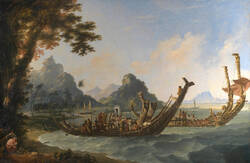Further Media
Producer unknown to us
Oceania, Polynesia, Tahiti/Society Islands (Moorea, Huahine, Raiatea, Taha'a)
Before 1781
Hibiscus wood, coconut fiber, blue-green and red feathers, shark teeth, mother-of-pearl discs, snails, dog hair
Acquired in 1773–74 or 1777 on Captain James Cook’s second or third expedition in the Pacific. It is yet unknown by whom the object was acquired.
Brought from Great Britain to Germany by Benjamin La Trobe, a Moravian working in London.
Inv. no. 68669
Tahitian breastplates, such as those in the Herrnhut Cook collection, could not be obtained for any goods during the first two visits of Captain Cook and his men to Tahiti and the Society Islands (1769/1773). Not even English metal goods, such as nails, axes, or saws, which were otherwise so coveted throughout Polynesia, made breastplates available for trade. Only high-ranking members of the aristocracy who traced their ancestry to the gods (ari'i) were entitled to such chest ornaments. The design of a taumi appears to have been identical throughout the Society Islands: a horseshoe-shaped latticework of thin, bicolored rods was decorated with three contrasting rows of feathers and bright shark’s teeth, with two or three mother-of-pearl disks at the top, again surrounded by feathers. The outer rim was draped with a gloriole of brightly shining dog hair.
The German naturalist Georg Forster, the scientific draftsman of Cook’s second circumnavigation, noted the use of these breastplates in Tahiti in April 1774: “When we approached O-Parre, we beheld one of the most magnificent sights which it is possible to be entertained with in the South Sea. This was a very numerous fleet of great war-canoes, lying arranged along the shore, completely fitted out, and manned with rowers and warriors, dressed in their robes, targets and towering helmets. … Their targets or breast-plates were made of wicker-work, covered with feathers and shark’s teeth, and hardly any of the warriors were without them.”
